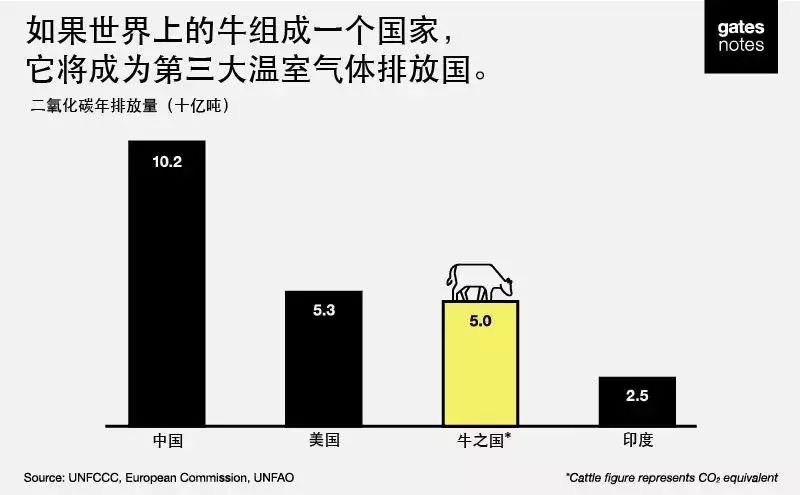本月18日,由微软联合创始人比尔·盖茨创办的创投基金Breakthrough Energy Ventures成立了一只1亿欧元的投资基金,帮助欧洲企业开发清洁技术。帮助有前途的公司将实验室的好想法投放到市场上进行推广。该基金表示,他们已经入股了一些核聚变、储能和生物技术的公司。
而开发清洁能源技术根本在于,当下整个社会正面临气候变暖的严峻形式。联合国政府间气候变化专门委员会(IPCC)刚刚发现,为了防止气候变化带来的最恶劣影响,我们必须在接下来10年每个经济领域的温室气体净排放量都达到零。
比尔·盖茨在最近的一次演讲中阐述了这一项目,更让我们详细了解了导致气候变暖的温室气体的来源。
下文,选择了其部分演讲。
温室气体的排放源自哪里?我想把它分为五大类——我称之为“阻止气候变化的五大挑战”:
电力(25%)。尽管可再生能源市场取得了进展,我们仍需要更多突破。例如,我们需要有除风能和太阳能之外备用的零排放能源,应对无风、长时间多云和夜晚的情况。我们还要使电网更高效,以便在需要的时间向需要的地方提供清洁能源。
农业(24%)。牛是甲烷的巨大来源。事实上,如果世界上的牛组成一个国家,将成为第三大温室气体排放国!此外的一个问题就是森林砍伐——例如腾出土地用于耕种——把能吸收空气中二氧化碳的树木砍掉了。当树木被焚烧时,它们又把所有的碳释放回大气中。

制造业(21%)。看看你周围的塑料、钢铁和水泥。所有这些共同作用,导致了气候变化。制造水泥和钢铁需要大量来自化石燃料的能量,在这过程中的化学反应会释放含碳的副产品。因此,即使我们可以用零排放能源制造出所有我们需要的东西,我们仍然需要处理副产品。
交通运输(14%)。低排放汽车很棒,但今天汽车只占交通相关碳排放量的一半不到,而且这一比例在未来还会继续降低。更多的排放来自飞机、货船和卡车。目前对于这些交通工具,我们没有任何实际的零排放选择。
建筑物(6%)。你在有空调的地方生活或工作吗?空调内的制冷剂就是一种温室气体。此外,运行空调、加热器、灯和其他电器需要耗费大量的能源。更高效的窗户和绝缘材料一类的东西会对此有所帮助。随着全球人口迁移到城市,这一领域在未来几十年将变得更加重要。到2060年,世界的建筑数量将增加一倍。打个比方,这等于是说在接下来的40年里,每个月将新诞生一个纽约市。
(第六个类别占剩下的那10%,即其他杂项,包括提取石油和天然气所需的能源等。)
我认为列出这些大挑战有助于我们思考气候变化。它们说明了能源不仅让你的房子和汽车正常运转,而且它几乎是生活每个部分的核心——食物、衣服、房子和你使用的产品。为了阻止地球继续变暖,我们需要在产品制造、粮食种植、人员交通和货物运输等方面取得突破,而不是只考虑如何为家庭和汽车供电。
这些挑战正变得越来越紧迫。全球的中产阶级正以前所未有的速度增长,随着收入增长,你的碳足迹也会增加。你可以买一辆自行车(它虽不使用汽油,但很可能是用能源密集型金属制成的,通过燃烧化石燃料的货船和卡车送到你手中),用来替代步行。最后你买了一辆摩托车,这样你就可以到离家更远的地方做一份更好的工作,从而付得起孩子的学费。你的家人能吃上更多的鸡蛋、肉和奶制品,这样他们就能获得更好的营养。你在市场购买冰箱和电灯,这样你的孩子可以在晚上学习,同时你也将自己置身于一个由金属和混凝土构成的坚固房屋之中。
所有这些新型消费切实改善了人们的生活。它对整个世界都有好处,但对气候来说非常糟糕,除非我们找到既能满足消费,又不向大气中排放更多温室气体的办法。
这无疑是一个棘手问题。取得重大突破的前景仍不明朗。我们很可能需要针对每项挑战提供多种解决方案。这就是为什么我们现在需要加大对全部五个领域的投资和研发。
以下为演讲实录摘要
Where do greenhouse gas emissions come from? I like to break it down into five main categories—what I call the grand challenges in stopping climate change:
Electricity (25%). Although there’s been progress in the renewable energy market, we still need more breakthroughs. For example, wind and solar need zero-carbon backup sources for windless days, long periods of cloudy weather, and nighttime. We also need to make the electric grid a lot more efficient so clean energy can be delivered where it’s needed, when it’s needed.
Agriculture (24%). Cattle are a huge source of methane; in fact, if they were a country, they would be the third-largest emitter of greenhouse gases! In addition, deforestation—clearing land for crops, for instance—removes trees that pull CO2 out of the air, and when the trees are burned, they release all their carbon back into the atmosphere.

Manufacturing (21%). Look at the plastic, steel, and cement around you. All of it contributed to climate change. Making cement and steel requires lots of energy from fossil fuels, and it involves chemical reactions that release carbon as a byproduct. So even if we could make all the stuff we need with zero-carbon energy, we’d still need to deal with the byproducts.
Transportation (14%). Low-emission cars are great, but cars account for a little less than half of transportation-related emissions today—and that share will shrink in the future. More emissions come from airplanes, cargo ships, and trucks. Right now we don’t have practical zero-carbon options for any of these.
Buildings (6%). Do you live or work in a place with air conditioning? The refrigerant inside your AC unit is a greenhouse gas. In addition, it takes a lot of energy to run air conditioners, heaters, lights, and other appliances. Things like more-efficient windows and insulation would help. This area will be more important over the next few decades as the global population moves to cities. The world’s building stock will double in area by 2060. That’s like adding another New York City every month for 40 years.
(The final 10% is a sixth, miscellaneous category that includes things like the energy it takes to extract oil and gas.)
I think these grand challenges are a helpful way to think about climate change. They show how energy isn’t just what runs your house and your car. It’s core to nearly every part of your life: the food you eat, the clothes you wear, the home you live in, the products you use. To stop the planet from getting substantially warmer, we need breakthroughs in how we make things, grow food, and move people and goods—not just how we power our homes and cars.
These challenges are only getting more urgent. The world’s middle class has been growing at an unprecedented rate, and as you move up the income ladder, your carbon footprint expands. Instead of walking everywhere, you can afford a bicycle (which doesn’t use gas but is likely made with energy-intensive metal and gets to you via cargo ships and trucks that run on fossil fuels). Eventually you get a motorbike so you can travel farther from home to work a better job and afford to send your kids to school. Your family eats more eggs, meat, and dairy, so they get better nutrition. You’re in the market for a refrigerator, electric lights so your kids can study at night, and a sturdy home built with metal and concrete.
All of that new consumption translates into tangible improvements in people’s lives. It is good for the world overall—but it will be very bad for the climate, unless we find ways to do it without adding more greenhouse gases to the atmosphere.
This is undoubtedly a tough problem. It is not obvious what the big breakthroughs will look like. Most likely we will need several solutions to each challenge. That is why we need to invest in lots of research and development, across all five areas, now.


